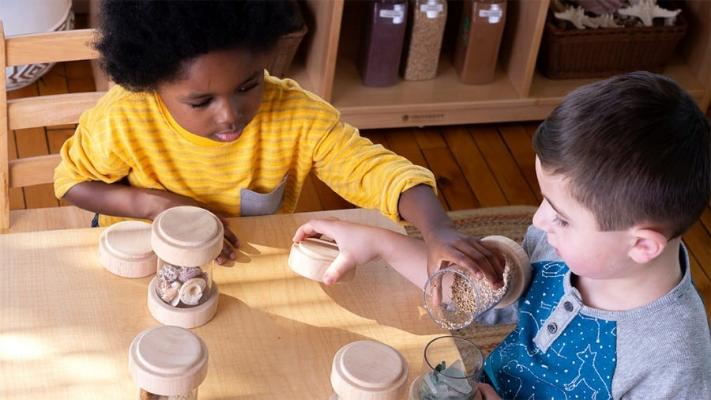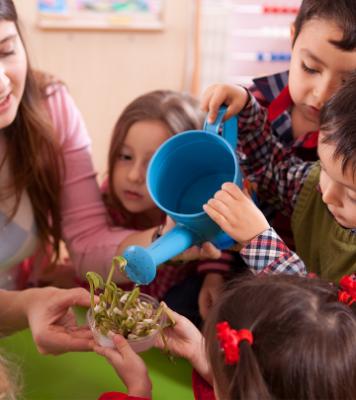Engaging preschoolers in social-emotional activities is super essential for their overall growth. These activities include fun games and role-playing, where kids learn to understand and control their feelings. They also learn to be kind and considerate by understanding how others feel. By playing together and sharing toys, they practice important social skills.
We encourage them to talk about their feelings and solve problems with words, not actions. Doing things like storytelling or art projects together helps them feel like they belong and are part of a team. These activities help them make friends and feel good about themselves, which is important for their happiness and success later on.
| We have many more activity ideas to help your child’s development, like Paper Bag Crafts For Kids, Outdoor Activities For Kids, and Show-and-Tell Ideas for Kids. |
10 Social-Emotional Activities For Preschoolers At Home 18-24 Months
- Emotion Faces Game: Print out pictures of different facial expressions representing various emotions like happy, sad, angry, etc. Show your child these pictures and ask them to identify the emotions. You can also make the corresponding facial expressions together.
- Pretend Play: Encourage imaginative play by providing props like dolls, stuffed animals, or toy kitchen sets. Pretend scenarios where they can act out different emotions, such as comforting a crying doll or expressing excitement about a pretend birthday party.
- Feelings Board Book: Read age-appropriate books about feelings with your child. Pause while reading to ask questions like, “How do you think the character feels?” or “What makes you feel that way?” This helps them understand emotions in context.
- Mirror Play: Sit in front of a mirror with your child and make various facial expressions. Encourage them to mimic your expressions and talk about how each expression might correspond to a different emotion.
- Sensory Play: Set up sensory bins with different materials like water, sand, or rice. Include toys and objects that elicit different tactile sensations. Talk about how the materials make them feel and encourage them to express their emotions.
- Music and Movement: Play music with different tempos and moods. Dance together, matching your movements to the music’s rhythm and mood. Discuss how the music makes them feel and encourage them to express themselves through movement.
- Emotion Sorting Game: Create flashcards or pictures of various emotions and ask your child to sort them into categories like “happy,” “sad,” or “angry.” This helps them recognize and categorize different feelings.
- Emotion Charades: Act out different emotions, like pretending to cry for “sad” or jumping for “excited.” Encourage your child to guess the emotion and then talk about a time when they felt that way.
- Empathy Stories: Read stories or watch videos together that showcase characters experiencing different emotions. Discuss how the characters might be feeling and brainstorm ways to help them feel better.
- Positive Affirmations: Create a daily routine of saying positive affirmations together, such as “I am brave,” “I am kind,” or “I am loved.” Encourage your child to repeat these affirmations and discuss what they mean. This helps build self-esteem and positive self-image.
10 Social-Emotional Development For Preschoolers At Childcare 18-24 Months
Here are ten social-emotional development activities suitable for preschoolers in childcare settings aged 18-24 months:
- Parallel Playgroups: Arrange playgroups where children can engage in parallel play, side by side with similar toys or activities. This allows them to observe and mimic each other’s behaviors, fostering social interaction.
- Emotion Flashcards: Introduce flashcards featuring simple facial expressions depicting various emotions. Encourage children to identify the emotions and discuss situations that might elicit those feelings.
- Group Story Time: Conduct regular group story sessions focusing on emotions and social situations. Use interactive storytelling techniques to engage children in discussions about characters’ feelings and actions.
- Empathy Building Activities: Organize activities that promote empathy, such as caring for dolls or stuffed animals. Encourage children to comfort and soothe the toys, helping them understand and respond to others’ emotions.
- Turn-Taking Games: Engage children in turn-taking games and activities, such as passing a ball or taking turns on a slide. Emphasize the importance of waiting for their turn and sharing with others.
- Emotion Puppet Play: Use puppets to act out simple scenarios involving emotions. Allow children to interact with the puppets and express their own feelings through role-play.
- Feelings Art: Provide materials for expressive art activities, such as drawing or painting. Encourage children to create artwork that reflects their emotions, using colors and shapes to convey feelings.
- Social Songs and Rhymes: Teach songs and rhymes that focus on social themes, such as friendship and cooperation. Singing together promotes a sense of community and shared experience.
- Emotion Exploration Baskets: Create themed baskets filled with objects representing different emotions (e.g., a soft toy for comfort and a mirror for self-reflection). Encourage children to explore the objects and discuss how they make them feel.
- Positive Reinforcement: Implement a system of positive reinforcement to recognize and praise children’s social-emotional achievements. Use verbal encouragement and small rewards to reinforce pro-social behaviors and interactions.
10 Social And Emotional Development Activities For 2-3 Year Olds

Here are some tailored social and emotional development activities suitable for 2-3-year-olds:
- Emotion Matching Game: Create cards or pictures depicting various facial expressions showing emotions like happiness, sadness, anger, and excitement. Encourage children to match the emotion cards to corresponding facial expressions or verbal cues.
- Feelings Puppet Show: Use puppets to act out scenarios involving different emotions. Children can participate by interacting with the puppets and expressing their feelings in similar situations.
- Friendship Circle Time: Gather children in a circle and discuss the importance of friendship and kindness. Encourage them to share their favorite things about their friends and practice taking turns listening and speaking.
- Emotion Charades: Play a game where children take turns acting out different emotions while others guess. This helps them recognize and express feelings through body language and facial expressions.
- Empathy Role-Playing: Set up role-playing scenarios where children can practice empathy and understanding. For example, one child can pretend to be upset, and others can offer comfort and support.
- Feelings Storybooks: Read age-appropriate storybooks that focus on emotions and social situations. Pause during the story to discuss how the characters might be feeling and why.
- Sharing and Turn-Taking Activities: Provide opportunities for children to practice sharing toys and taking turns during playtime. Praise and reinforce positive behaviors like sharing and waiting patiently.
- Feelings Art Collage: Provide children with magazines, newspapers, and art supplies to create a collage representing different emotions. Encourage them to discuss their artwork and explain why they chose specific images.
- Emotion Dance Party: Play music with different tempos and moods and encourage children to express themselves through dance. Talk about how the music makes them feel and encourage them to move their bodies accordingly.
- Feelings Check-In: Start each day or session with a feelings check-in where children can express their feelings using pictures, words, or gestures. This helps them develop self-awareness and communicate their emotions effectively.
FAQs
What is social-emotional for toddlers?
Social-emotional development for toddlers involves learning to understand and express emotions, forming relationships with others, and developing skills like sharing, empathy, and self-regulation.
What are the five emotional activities?
Here are the five emotional activities with headings in bold:
- Emotion Recognition
Helping children identify and understand different emotions through pictures, stories, or facial expressions.
- Emotional Expression
Providing opportunities for children to express their feelings through art, play, or discussions.
- Empathy Building
Encouraging children to understand and share the feelings of others, often through role-playing or storytelling.
- Emotional Regulation
Teaching children strategies to manage their own emotions, such as deep breathing or taking a break when upset.
- Social Skills Development
Engaging children in activities that promote positive interactions with peers, including sharing, turn-taking, and cooperation.

